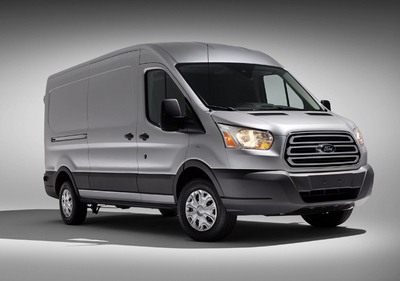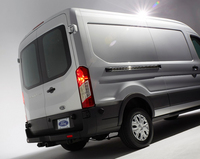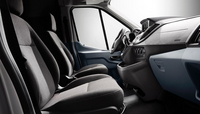2015 Ford Transit Preview by Carey Russ +VIDEO
 2015 Ford Transit |
DRIVING DOWN THE ROAD WITH CAREY RUSS
• SEE ALSO: Ford Buyers Guide
 2015 Ford Transit |
After 53 years of production, and being the class sales leader for the past 35 years, Ford's venerable American-style van is history. For 2015 and beyond, the E-Series, previously known as the Econoline, full-size van gives way to the European-style Transit family.
Ford's "One Ford" worldwide product strategy is alive and well. It's given Americans cars like the Fiesta and Focus, little-changed from their overseas counterparts. It's given Europeans the mid-size Fusion, known there as the Mondeo. And now it gives Americans many more choices to fill needs for passenger and/or cargo duty above and beyond what even the capabilities of a large SUV -- or the E-Series. The Transit has been sold nearly everywhere except North America, while the E-Series has been sold primarily in North American markets, with some sales in the Middle East and assembly in China.
The Transit nameplate has been around even longer than the Econoline, as it was first used for a German-built small van in 1953. The first widely-built and -exported Transit came about in 1965, and was built in England, various European countries, and Turkey. Ford has been an international company for a long time.There have been four more generations since then, with the newest debuting in Europe for 2014 and here now. European production is in Turkey; American assembly is near Kansas City, MO.
A major reason for the Transit's success through the years has been a wide choice of body styles for a wide variety of jobs. Unlike the late E-Series van, which came in cargo, freight, or chassis/cab (for motorhome, ambulance, etc conversion) with one body style, our new Transit is offered in three body lengths on two wheelbases, with three roof heights in cargo van, passenger wagon, chassis cab, and cutaway body styles. It's a truck, but the new Transit uses car-like unibody construction for strength with lighter weight and a quieter interior. Extensive use of boron steel, especially in higher sections, keeps the center of gravity low, for improved road manners. Front suspension is by MacPherson struts, with a solid axle and leaf springs in the rear. Brakes are four-wheel disc with antilock.
There are three engine choices. Standard spec is a naturally-aspirated 3.7-liter V6 with 275 horsepower and 260 lb-ft of torque. Need more? That would be the 3.5-liter "EcoBoost" turbo V6 familiar from the F150 pickup. With 310 hp and 400 lb-ft there is no need for a V8. Want better fuel economy and a longer cruising range? That would be the 3.2-liter "Power Stroke" inline five-cylinder turbodiesel, with 185 hp and 350 lb-ft. All are matched to a six-speed automatic transmission, in front-engine, rear-wheel drive configuration.
The two wheelbases are 129.9 inches -- "medium" -- and 147.6 inches for "long". The last E-Series was 138 inches. Medium wheelbase height is 83.6 inches for the "low roof" or 100.8 inches for the "medium roof" model. LWB low- and medium-roof versions are similar, while the LWB high-roof is 109.4 to 110.1 inches high depending on configuration. Width to the ends of the outside mirrors is 97.4 inches, or 81.3 for the body only except for the dual rear-wheel version's 82.0 inches. Potential cargo volume ranges from 246.7 to 487.3 cubic feet. I think I've lived in smaller spaces… Passenger wagons can seat eight to fifteen people -- including luggage. Depending on configuration, payloads range up to 4,650 lbs, towing can be as much as 7,500 lbs, and GVWR up to 10,360 lbs. There are something like 58 possible configurations, not counting aftermarket conversions.
Like the E-Series, the Transit is primarily a commercial vehicle. Which means that you'll be seeing Transits and variations thereof used for delivery service, airport and hotel shuttle busses, ambulances, small school busses, and specialized trade vehicles. Ford's recent presentation was geared to those customers, with a large amount of aftermarket participation. Meaning that there is readily-available shelving, cabinets, and almost everything needed for a wide variety of trade use.
There are also chassis cab versions, for box van and flatbed use, and walk-through cutaway models for motorhome conversions. Most of the safety and connectivity systems found in passenger cars today can be had in a Transit. The Lane-Keeping System with Lane-Keeping Alert and Driver Alert, a rear-view camera with trailer-hitch assist, a reverse-sensing system, Sync, MyFord Touch, and the Crew Chief inventory system introduced in the smaller Transit Connect will be offered. As will the Personal Safety System, AdvanceTrac with RSC stability control, the Safety Canopy airbag system, MyKey programmable keys, and anti-theft systems and alarms.
 2015 Ford Transit |
With increased capacity but not necessarily increased weight, and more-efficient engines, Ford expects the cost of ownership and operation to be much less than an equivalent E-Series van. The 3.5 EcoBoost engine is expected to be good for 14 mpg city and 19 on the highway (EPA ratings). That's impressive considering vehicle size. The equivalent E-Series would have the 6.8-liter V10 and be good for 10 and 13. Diesel? No official figures but I asked. Low 20s highway expected.
Which fits with the Transit's closest competitor here, the Mercedes-Benz Sprinter. A friend who has spent time in Europe purchased one of those back when it was sold as a Dodge by DaimlerChrysler. Why? Interior height -- no need to stoop or whack your head when loading a motorcycle in the back -- and it can take two large or three medium-sized bikes easily. I've spent ample time in that one, as passenger and driver, over the years. Plenty of power from the 2.3-liter five-cylinder turbodiesel, cruises happily at regular highway speeds, and 22 mpg no matter what. That high, narrow box looks like it would be a handful in crosswinds, but isn't. And its turning circle and maneuverability rival that of quite a few cars. So I was especially interested in driving the Transit for comparison.
Ford benchmarked the competition well. To be sure, my friend's Sprinter is nearing ten years of service, and has approximately no soundproofing aft of the front cabin. Ford had a good variety of new Transits available for short drives on a local highway and access roads -- and an autocross course.
No you didn't rear that wrong. Autocross, as in cones in a parking lot to emphasize maneuverability and cornering power. You might think that that would be a dangerously stupid thing to do with a van. Not necessarily -- the Transit, even in long-wheelbase medium- and high-roof form carries its weight low and turns easily. No, it wouldn't be as quick around the course as, say, a Lotus 7 -- but you could fit the Seven and plenty of spare parts inside.
I drove a long-wheelbase, medium-height example powered by the 3.7-liter engine first. Good acceleration considering the size, comfortable and noticeably quieter inside than an aging Sprinter even though it was a cargo van. There is good attention to detail in soundproofing in the rear area -- it's not luxury car quiet but there was minimal drumming and thrumming. It's big, but long and high more than wide, so turning in a tight area was not difficult. This example had the backup camera, a necessity given the size and (lack of close-up) visibility through the rear window and mirrors. Back in the large parking lot, the autocross course was most amusing. No, I wasn't going all that fast, but quicker than would be expected from the Transit's size. Long ago I had a delivery job, with an aging Econoline one of the vehicles used. The Transit is far, far beyond that in comfort and road ability. And likely far less thirsty -- that Econoline was doing well to break into double digits.
Next up in the short program was the turbodiesel, also in medium-wheelbase, medium-roof cargo form. Very little difference from the 3.7, with good acceleration considering size and weight, and minimal engine noise. The same easy maneuverability and good brakes. Both versions felt like a contemporary car, in extra-large size, not at all like an old truck.
A Transit is unlikely to be a common personal-use vehicle, barring the comeback of 70s-style custom vans. But if you often carry large things that should be securely out of sight or carry more people than can fit comfortably in a large SUV or minivan, you might want to investigate. And if you need something like this for a work vehicle, a Transit is a definite consideration. Prices start in the high $20,000 range for the basic low-roof van and range upward from there. If long-distance travel is a consideration, Ford has a larger dealer network than any of its competitors in this class. Transits are on sale now, although full production of all possible variations may not be complete.


